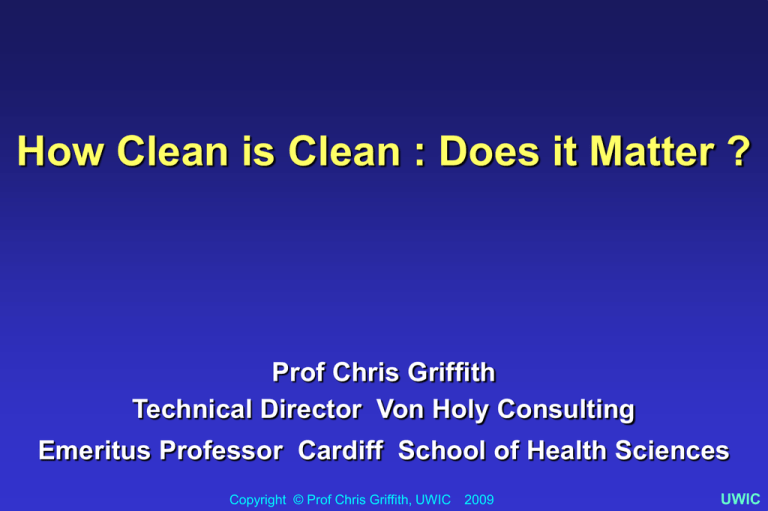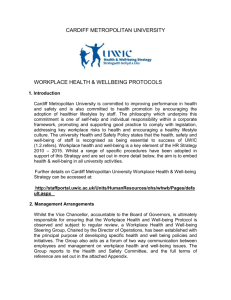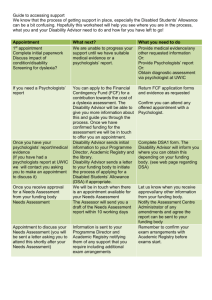How_Clean_is_Clean_DubaiHandout
advertisement

How Clean is Clean : Does it Matter ? Prof Chris Griffith Technical Director Von Holy Consulting Emeritus Professor Cardiff School of Health Sciences Copyright © Prof Chris Griffith, UWIC 2009 UWIC Contents • • • • • • Cleaning , Soil and Disinfection Allergens , biofilms and food safety Possibilities after cleaning Testing surface cleanliness How clean is clean ? Surface Testing and End product testing Copyright © Prof Chris Griffith, UWIC 2006 UWIC Cleaning Cleaning • Removal of soil UWIC Soil • • • • Matter out of place Organic soil –carbohydrates,proteins,lipids Mineral salts Other chemical soils-lubricants , metal oxides • Associated microorganisms Copyright © Prof Chris Griffith, UWIC 2006 UWIC Cleaning Cleaning • Removal of soil Disinfection • Destruction or removal of microorganisms Aim: to reduce to an acceptable level - little or no risk UWIC Why is cleaning important ? • Food Safety --–chemical and microbiological l • Chemical residues -potential allergen contamination ,contribute to biofilms • Residual microorganisms increase the risk of foodborne disease • Residual moisture increases chances of biofilm formation, microbial survival and transfer UWIC Food Allergies • Allergens – Normally proteins – Cause an IgE related immune response – Food often more than 1 protein • Most reactions mild BUT anaphylaxis • Only very small amounts needed Copyright © Prof Chris Griffith, UWIC 2006 UWIC How Clean is Clean: Allergens Allergen Clean • Clean to a level that removes residual allergenic protein from the product zone and adjacent areas to prevent cross contamination to subsequent product runs • Links to quantity in food and quantity to trigger a reaction 8 UWIC What is a Biofilm? “Aggregation of microorganisms and their associated extracellular substances, actively attached to, growing and multiplying on a surface” “Complex consortium of microorganisms enmeshed within an extracellular matrix” UWIC Residual Microorganisms in the Food Production Environment and Food Safety/Quality UWIC Surface Counts and Product Contamination • 4 yr Listeria monocytogenes study –JFP 2008 • 46% product isolates and 41% surface • Persistent strains even after cleaning /dis infection –2 year period • Strains on gloves /floors Copyright © Prof Chris Griffith, UWIC 2006 UWIC After closure of dairy A , approximately 100 additional environmental and product samples were collected from the dairy's processing facility and adjacent retail store on January 2, 2008. One environmental swab from a floor drain in the finished product area, one skim milk sample, and seven flavored milk samples tested positive for L. monocytogenes and matched the outbreak strain by PFGE using the two restriction enzymes. Outbreak of Listeria monocytogenes Infections Associated with Pasteurized Milk from a Local Dairy - Massachusetts, 2007 MMWR Weekly, 10th October 2008 / 57(40);1097-1100 UWIC The dairy’s records indicated the pasteuriser met standards for time/temperature and flow rate . They did not have an environmental monitoring programme . Contamination with the outbreak strain was found in close proximity to areas where hoses were used to clean equipment The milk plant was closed due to the financial burden Outbreak of Listeria monocytogenes Infections Associated with Pasteurized Milk from a Local Dairy - Massachusetts, 2007 MMWR Weekly, 10th October 2008 / 57(40);1097-1100 UWIC Lm detected in 70(3.5%)env swabs and 16(7.4% ) product from Swiss sandwich plant. Of the 86 isolates 93% were serotype 1/2a with 6 genetic profiles . 78% belonged to one genotype found on slicers , conveyors, tables,bread feeding machine salmon, and egg sandwiches . These strains persisted for more than 9 months on slicers and conveyors . Revision of cleaning programmes solved the problem . Emphasizes impt of env monitoring to identify potential contamination problems and as early warning Food Control April 2010 UWIC Examples of Lm Plant Persistence by Product Cheese 11month – 7 years Fish months – 4 years Meat months – 5 years Poultry 12 years Tompkin Journal of Food Protection UWIC Maple Leaf Plant Reopens after Listeria Outbreak • 20 Deaths and estimated Cost of $20 m –Aug /Sept 2008 • CEO said the slicing equipment at the plant will now be subject to stricter cleaning and testing , including disassembling The CEO said the machines had been cleaned on a daily, weekly and monthly basis but it wasn’t until the machines were disassembled that they found the area where the bacteria had become embedded Copyright © Prof Chris Griffith, UWIC 2009 UWIC Salmonelllosis Salmonella Enteritidis infections associated with a contaminated immersion blender, New Hampshire, 2009 This outbreak of Salmonella Enteritidis was caused by a Salmonella-contaminated immersion blender. A malfunctioning blender shaft seal is suspected to have resulted in poor cleaning leading to contamination of the products prepared using the blender. Copyright © Prof Chris Griffith, 2009 UWIC A BIG Case of Recontamination! USA 1994, 224,000 customers suffered Salmonella food poisoning from eating ice-cream due to poor cleaning of bulk transporters. Tolley January, 1998 Copyright © Prof Chris Griffith, UWIC 2008 UWIC Surface Cleanliness and Ice Cream Contamination • Enterobacteriaceae should be largely destroyed by Pasteurisation • Studies in UK 15% Ireland 6.5 % : Spain 47% were unsatisfactory with some counts in excess of 106 Copyright © Prof Chris Griffith, UWIC 2006 UWIC Characteristics of 4 Most Important Emerging Pathogens ID X Cont Severity STEC Low Yes Lm Low * Yes Severe Campylobacter Low Yes Moderate Norovirus Low Yes Copyright © Prof Chris Griffith, UWIC 2006 Severe Mild UWIC Importance of the food environment “if an organism is found in the food environment there is a 70% chance of it getting into the food.” IAFP Rome 2007 UWIC Why cleaning is important • Food Safety --–microbiological and chemical • Shelf life • Legal or other requirement UWIC Requirements for Cleaning :Legislation EU Regs 852/2004 • Food Premises are to be kept clean and maintained in good repair and condition. • Layout, design and construction —permit adequate cleaning and disinfection ---protect against accumulation of dirt • Cleaning agents and disinfectants are not to be stored in areas where food is handled Copyright © Prof Chris Griffith, UWIC 2009 UWIC Dubai Municipality Admin Order 20 • Chapter 5 Requirements relating to Design Facilities and Operation • Chapter 7 Requirements relating to Control of Food Storage and Cross Contamination • Chapter 9 Guidelines for Cleaning and Disinfection Copyright © Prof Chris Griffith, UWIC 2009 UWIC BRC Global Standard for Food Safety 2008 Section 4: 4.9 Hygiene and Housekeeping Cleaning procedures in place Trained Personnel Cleaning chemicals fit for purpose Cleaning practices to minimise risk of cross contamination Effectiveness of cleaning verified and recorded Procedures revalidated Copyright © Prof Chris Griffith, UWIC 2008 UWIC ISO 22000: • Guidance and workbook: Sanitation and cleaning. • All aspects appropriately cleaned and disinfected on a regular basis. • Well organised hygiene cleaning programme • Defined standard of results. Copyright © Prof Chris Griffith, UWIC 2008 UWIC Other Reasons Why Cleaning is Important In Addition to Food Safety and Legality: • Pleasant and safe work environment (removes dirt and grease) • Auditor/ customer confidence (promotes favourable image) • Aids pest control (removes food and pests easier to see) • Increased shelf life and equipment performance • Reduction in: – Food wastage Surface deterioration – Customer complaints Wear and tear – Physical contamination Copyright © Prof Chris Griffith, UWIC 2008 UWIC What should a surface be like after cleaning ? AND How Clean is Clean ? UWIC How to Test for Cleanliness: Characteristics of an Ideal Method • Detects microorganisms and food residues with sufficient sensitivity • Works equally well on wet and dry surfaces • Repeatable / Reproducible • Easy to use • Rapid • Cheap • Foolproof / recordable UWIC Assessing Cleanliness • No ideal method • Any testing usually better than none but limitations recognised UWIC Microbiology • No accepted standard / optimum method • ISO 18593 • Highly variable results Moore G and Griffith, C.J. (2007) Problems Associated with Traditional Hygiene Swabbing: The Need for Standardisation. Journal of Applied Microbiology; 103: 10901103 UWIC ISO 18593 – Surface Sampling Techniques • • • • • Covers swabbing and contact methods Swabbing diluent Clean and disinfect after sampling Sponges / cloths 100cm2 Lot of variability allowed • • • • • Low temperature swab transport 1-4C < 24hrs Contact plate 4 hours Results used for “trend analysis” Use of Rt sampling pattern Contact plate not recommended for pathogens Copyright © Prof Chris Griffith, UWIC 2006 UWIC Microbiology: Considerations • Is useful as part of an integrated approach • What do you need to know – Cleaning or contamination • General contamination: presence/absence of pathogens • Nature / shape of surface • Direct/ Indirect contact • Care with wetting solution if swabbing UWIC Visual Assessement “In isolation visual assessment is not a good indicator of surface cleanliness” Griffith, 2005 Handbook of Hygiene Control in the Food Industry Copyright © Prof Chris Griffith, UWIC 2007 UWIC Relative Merits of Component Residues • Universality - wide range foods • Quantity in food • Sensitivity of Test • Other – cost – time taken – simplicity UWIC Non Microbial: Food Component Residues Sole or Combination • ATP • Protein • Reducing Sugar • Other UWIC What is ATP ? • ATP=Adenosine Triphosphate • Residual surface Soil- blood , faeces, cells etc contain ATP • ATP on surface converted into LIGHT • Light measured in a luminometer • More light =more residual surface soil • More residual surface soil less effective the cleaning UWIC Testing For Allergens : Direct and Indirect •Direct –protein detection –sensitivity •Direct specific allergen peanut,hazelnut,almond,sesame,soya,egg,milk caesin,crustacean,wheat gluten,sulphite •Elisa/lateral flow •Indirect -ATP UWIC What is Clean? • What is acceptable / Fitness for purpose ? • What is attainable? UWIC Setting Standards: Why? • “Cannot manage what cannot measure” • Need to know where you are • Benchmarking • Scientific approach Copyright © Prof Chris Griffith, UWIC 2007 UWIC What is Acceptable? • USA <5cfu / cm2 • SFSA Target Max • EU / UK Meat legislation <10cfu / cm2 1cfu / cm2 Enterobacteriaceae • Australia 1cfu / cm2 3cfu / cm2 Sat <5cfu / cm2 Unsat <10cfu/cm2 Copyright © Prof Chris Griffith, UWIC 2009 UWIC What is Attainable? • UWIC <2.5cfu / cm2 or 250/500 RLUs Copyright © Prof Chris Griffith, UWIC 2005 UWIC End Product and Surface Testing Both are Important and both tell you something about your systems BUT Copyright © Prof Chris Griffith, UWIC 2007 UWIC End Product and Surface Testing Both are Important and both tell you something about your systems BUT End Product Testing tells you something may HAVE GONE wrong Surface testing tells you if something may GO wrong in the future Griffith, 2008 Copyright © Prof Chris Griffith, UWIC 2007 UWIC EU Criteria Regs 2073/2005 Sampling of the production and processing environment can be a useful tool to identify and prevent the presence of pathogenic microorganisms in food. UWIC Summary • Definition of terms • Presence of Residues or Microorganisms on surfaces can pose a health risk • Important to assess and test surface after cleaning • Variety of methods –integrated approach • Benchmark values • Predictive nature of surface testing Copyright © Prof Chris Griffith, UWIC 2006 UWIC Summary 2 • Assessing cleanliness important in Management - validation, monitoring and verification • • • • Variety of test methods Integrated Strategy: micro and non-micro ATP valuable rapid technique Assessing cleaning can provide an early/advance warning of food safety problems Copyright © Prof Chris Griffith, UWIC 2009 UWIC



